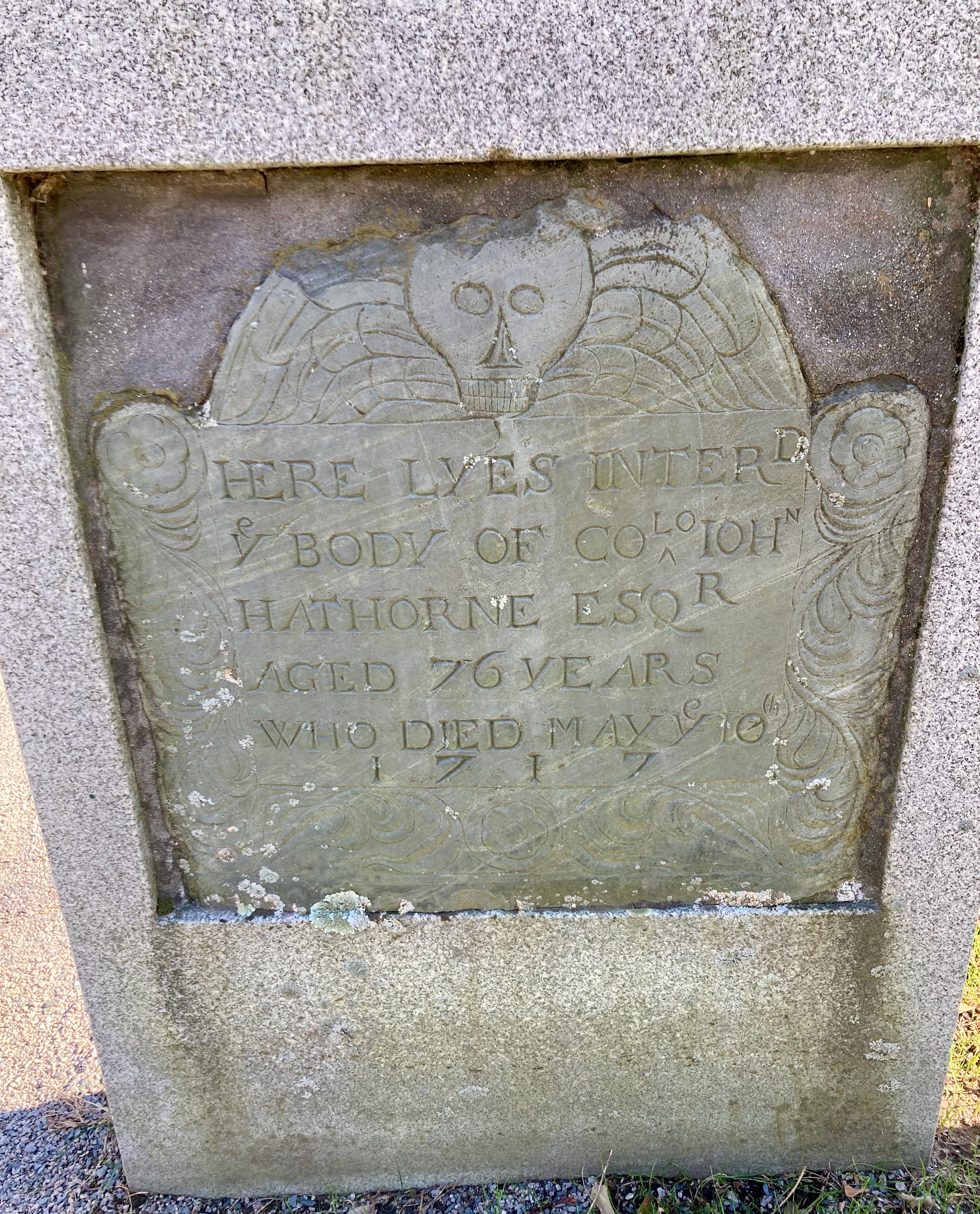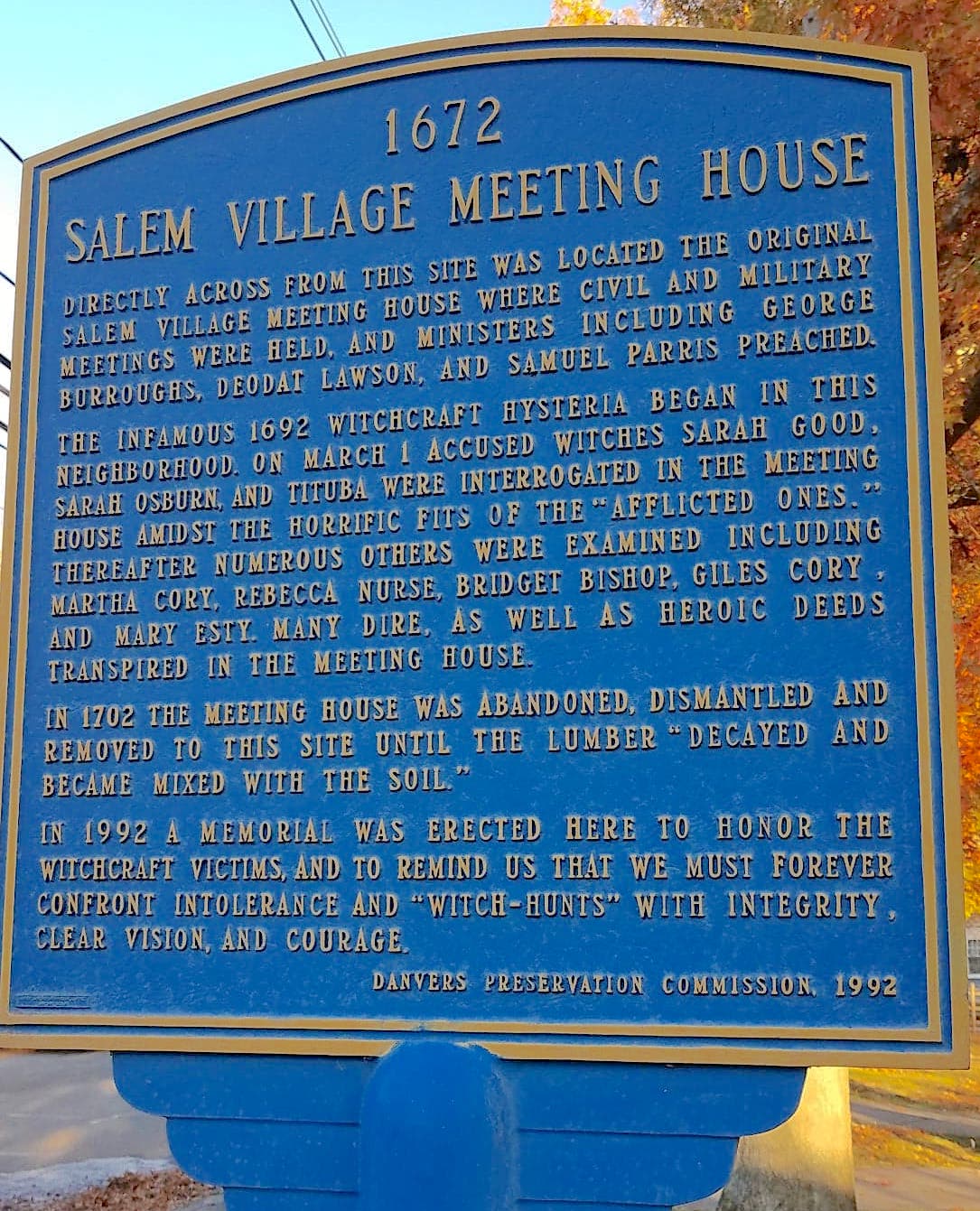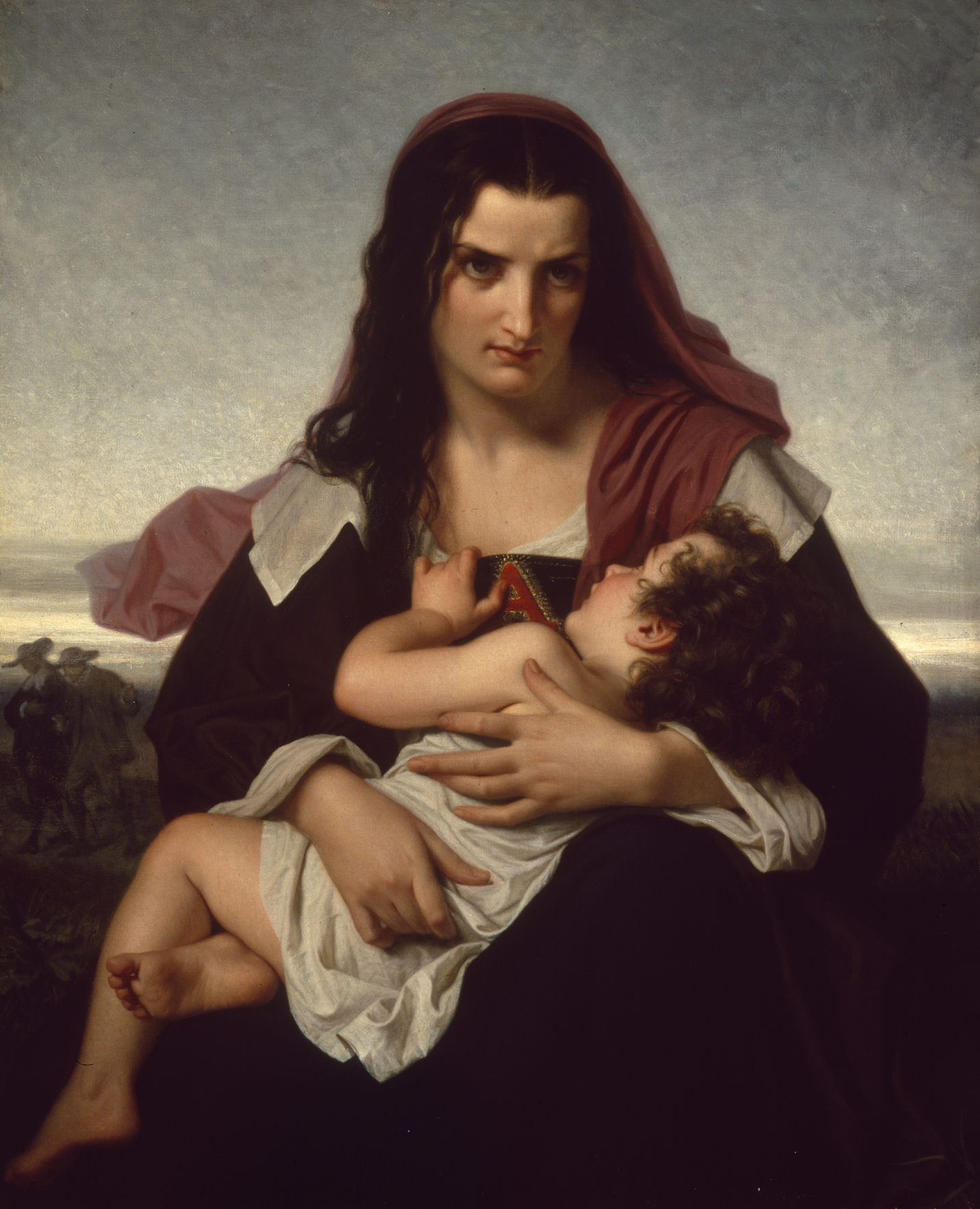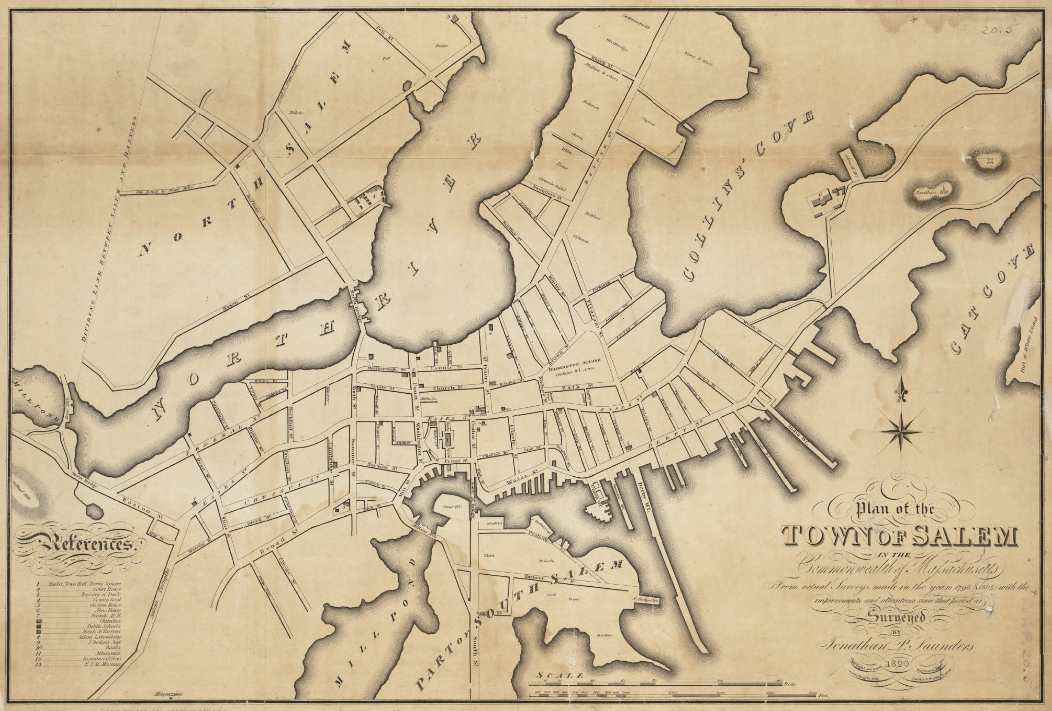|
John Hathorne
John Hathorne (August 1641 – May 10, 1717) was a merchant and magistrate of the Massachusetts Bay Colony and Salem, Massachusetts. He is best known for his early and vocal role as one of the leading judges in the Salem witch trials. Hathorne was absent from the list of men appointed to the Court of Oyer & Terminer in June 1692. That court relied heavily on the spectral evidence, examinations, interrogations, and affidavits previously conducted by Hathorne, co-signed by Jonathan Corwin, and recorded by Rev. Samuel Parris and/or Ezekiel Cheever Jr. On September 22, 1692, the date of the final eight executions, Hathorne was present at a meetingSewall Diary with Stoughton and Cotton Mather to discuss using court records in a new publication designed to promote the trials. Unlike Samuel Sewall, Hathorne is not known to have repented for his actions. He was a Patrilineality, patrilineal ancestor of writer Nathaniel Hawthorne. Life Hathorne's father, Major William Hathorne, was ... [...More Info...] [...Related Items...] OR: [Wikipedia] [Google] [Baidu] |
Salem, Massachusetts
Salem ( ) is a historic coastal city in Essex County, Massachusetts, located on the North Shore of Greater Boston. Continuous settlement by Europeans began in 1626 with English colonists. Salem would become one of the most significant seaports trading commodities in early American history. It is a suburb of Boston. Today Salem is a residential and tourist area that is home to the House of Seven Gables, Salem State University, Pioneer Village, the Salem Maritime National Historic Site, Salem Willows Park, and the Peabody Essex Museum. It features historic residential neighborhoods in the Federal Street District and the Charter Street Historic District.Peabody Essex announces $650 million campaign WickedLocal.com, November 14, 2011 [...More Info...] [...Related Items...] OR: [Wikipedia] [Google] [Baidu] |
Danvers, Massachusetts
Danvers is a town in Essex County, Massachusetts, United States, located on the Danvers River near the northeastern coast of Massachusetts. The suburb is a fairly short ride from Boston and is also in close proximity to the renowned beaches of Gloucester and Revere. Originally known as Salem Village, the town is most widely known for its association with the 1692 Salem witch trials. It was also the site of Danvers State Hospital, one of the state's 19th-century psychiatric hospitals. Danvers is a local center of commerce, hosting many car dealerships and the Liberty Tree Mall. As of the 2020 United States Census, the town's population was 28,087. History Pre-Columbian era The area was long settled by indigenous cultures of Native Americans. In the historic period, the Massachusett, a tribe of the Pequot language family, dominated the area. The land that is now Danvers was once owned by the Naumkeag branch of the Massachusett tribe. Salem Village Around 1630, English colonists im ... [...More Info...] [...Related Items...] OR: [Wikipedia] [Google] [Baidu] |
The House Of The Seven Gables
''The House of the Seven Gables: A Romance'' is a Gothic novel written beginning in mid-1850 by American author Nathaniel Hawthorne and published in April 1851 by Ticknor and Fields of Boston. The novel follows a New England family and their ancestral home. In the book, Hawthorne explores themes of guilt, retribution, and atonement, and colors the tale with suggestions of the supernatural and witchcraft. The setting for the book was inspired by the Turner-Ingersoll Mansion, a gabled house in Salem, Massachusetts, belonging to Hawthorne's cousin Susanna Ingersoll, as well as ancestors of Hawthorne who had played a part in the Salem Witch Trials of 1692. The book was well received upon publication and later had a strong influence on the work of H. P. Lovecraft. ''The House of the Seven Gables'' has been adapted several times to film and television. Plot The novel is set in the mid-19th century, but flashbacks to the history of the house, which was built in the late 17th century ... [...More Info...] [...Related Items...] OR: [Wikipedia] [Google] [Baidu] |
The Scarlet Letter
''The Scarlet Letter: A Romance'' is a work of historical fiction Historical fiction is a literary genre in which the plot takes place in a setting related to the past events, but is fictional. Although the term is commonly used as a synonym for historical fiction literature, it can also be applied to other ty ... by American author Nathaniel Hawthorne, published in 1850. Set in the Puritan Massachusetts Bay Colony during the years 1642 to 1649, the novel tells the story of Hester Prynne, who conceives a daughter with a man to whom she is not married and then struggles to create a new life of repentance and dignity. Containing a number of religious and historic allusions, the book explores themes of Legalism (theology), legalism, sin and Guilt (emotion), guilt. ''The Scarlet Letter'' was one of the first mass-produced books in the United States. It was popular when first published and is considered a classic work of American literature. The novel has inspired numerous film, te ... [...More Info...] [...Related Items...] OR: [Wikipedia] [Google] [Baidu] |
Judge John Hathorne Tombstone
A judge is a person who presides over court proceedings, either alone or as a part of a panel of judges. A judge hears all the witnesses and any other evidence presented by the barristers or solicitors of the case, assesses the credibility and arguments of the parties, and then issues a ruling in the case based on their interpretation of the law and their own personal judgment. A judge is expected to conduct the trial impartially and, typically, in an open court. The powers, functions, method of appointment, discipline, and training of judges vary widely across different jurisdictions. In some jurisdictions, the judge's powers may be shared with a jury. In inquisitorial systems of criminal investigation, a judge might also be an examining magistrate. The presiding judge ensures that all court proceedings are lawful and orderly. Powers and functions The ultimate task of a judge is to settle a legal dispute in a final and publicly lawful manner in agreement with substantial p ... [...More Info...] [...Related Items...] OR: [Wikipedia] [Google] [Baidu] |
Charter Street Historic District
The Charter Street Historic District encompasses a small remnant of the oldest part of Salem, Massachusetts that has since been surrounded by more modern development. It includes three properties on Charter Street: the Pickman House, the Grimshawe House, and the Charter Street Cemetery, or Central Burying Point. The district was listed on the National Register of Historic Places in 1975. Pickman House The Pickman House is located on Charter Street behind the Peabody Essex Museum, the oldest continually operated museum in America. The house, built in 1664 and is located on Charter Street. The house was restored by Historic Salem in 1969 and purchased by the museum in 1983. It stands just east of the cemetery entrance on the south side of Charter Street. Grimshawe House The Grimshawe House is a Federal style three story wood-frame house that was built c. 1770, which stands just west of the cemetery entrance. It is most significant for its association with writer Nathaniel ... [...More Info...] [...Related Items...] OR: [Wikipedia] [Google] [Baidu] |
Joseph Dudley
Joseph Dudley (September 23, 1647 – April 2, 1720) was a colonial administrator, a native of Roxbury in Massachusetts Bay Colony, and the son of one of its founders. He had a leading role in the administration of the Dominion of New England (1686–1689) which was overthrown in the 1689 Boston revolt. He served briefly on the council of the Province of New York where he oversaw the trial which convicted Jacob Leisler, the ringleader of Leisler's Rebellion. He then spent eight years in England in the 1690s as Lieutenant-Governor of the Isle of Wight, including one year as a Member of Parliament for Newtown (Isle of Wight). In 1702, he returned to New England after being appointed governor of the Province of Massachusetts Bay and Province of New Hampshire, posts that he held until 1715. His rule of Massachusetts was characterized by hostility and tension, with political enemies opposing his attempts to gain a regular salary and regularly making complaints about his official a ... [...More Info...] [...Related Items...] OR: [Wikipedia] [Google] [Baidu] |
Fredericton, New Brunswick
Fredericton (; ) is the capital city of the Canadian province of New Brunswick. The city is situated in the west-central portion of the province along the Saint John River, which flows west to east as it bisects the city. The river is the dominant natural feature of the area. One of the main urban centres in New Brunswick, the city had a population of 63,116 and a metropolitan population of 108,610 in the 2021 Canadian Census. It is the third-largest city in the province after Moncton and Saint John. An important cultural, artistic, and educational centre for the province, Fredericton is home to two universities, the New Brunswick College of Craft and Design, and cultural institutions such as the Beaverbrook Art Gallery, the Fredericton Region Museum, and The Playhouse, a performing arts venue. The city hosts the annual Harvest Jazz & Blues Festival, attracting regional and international jazz, blues, rock, and world artists. Fredericton is also an important and vibrant c ... [...More Info...] [...Related Items...] OR: [Wikipedia] [Google] [Baidu] |
Siege Of Fort Nashwaak (1696)
The siege of Fort Nashwaak occurred during King William's War when New England forces from Boston attacked the capital of Acadia, Fort Nashwaak, at present-day Fredericton, New Brunswick. The siege was in retaliation for the French and Indian Siege of Pemaquid (1696) at present day Bristol, Maine. In the English Province of Massachusetts Bay. Colonel John Hathorne and Major Benjamin Church were the leaders of the New England force of 400 men. The siege lasted two days, between October 18–20, 1696, and formed part of a larger expedition by Church against a number of other Acadian communities. Historical context During King William's War - the first of the four French and Indian Wars - French and Indians were victorious in the Siege of Pemaquid (1696) (present day Bristol, Maine) earlier that year. In the Siege of Pemaquid, the French and Indians had destroyed Fort William Henry, which the English colonial militia leader Benjamin Church himself assisted in erecting. In resp ... [...More Info...] [...Related Items...] OR: [Wikipedia] [Google] [Baidu] |
King William's War
King William's War (also known as the Second Indian War, Father Baudoin's War, Castin's War, or the First Intercolonial War in French) was the North American theater of the Nine Years' War (1688–1697), also known as the War of the Grand Alliance or the War of the League of Augsburg. It was the first of six colonial wars (see the four French and Indian Wars, Father Rale's War and Father Le Loutre's War) fought between New France and New England along with their respective Native allies before France ceded its remaining mainland territories in North America east of the Mississippi River in 1763. For King William's War, neither England nor France thought of weakening their position in Europe to support the war effort in North America. New France and the Wabanaki Confederacy were able to thwart New England expansion into Acadia, whose border New France defined as the Kennebec River in southern Maine. According to the terms of the 1697 Peace of Ryswick that ended the Nine Years' ... [...More Info...] [...Related Items...] OR: [Wikipedia] [Google] [Baidu] |
William Stoughton (Massachusetts)
William Stoughton (1631 – July 7, 1701) was a New England Puritan magistrate and administrator in the Province of Massachusetts Bay. He was in charge of what have come to be known as the Salem Witch Trials, first as the Chief Justice of the Special Court of Oyer and Terminer in 1692, and then as the Chief Justice of the Superior Court of Judicature in 1693. In these trials he controversially accepted spectral evidence (based on supposed demonic visions). Unlike some of the other magistrates, he never admitted to the possibility that his acceptance of such evidence was in error. After graduating from Harvard College in 1650, he continued religious studies in England, where he also preached. Returning to Massachusetts in 1662, he chose to enter politics instead of the ministry. An adept politician, he served in virtually every government through the period of turmoil in Massachusetts that encompassed the revocation of its first charter in 1684 and the introduction of its second ... [...More Info...] [...Related Items...] OR: [Wikipedia] [Google] [Baidu] |
William Phips
Sir William Phips (or Phipps; February 2, 1651 – February 18, 1695) was born in Maine in the Massachusetts Bay Colony and was of humble origin, uneducated, and fatherless from a young age but rapidly advanced from shepherd boy, to shipwright, ship's captain, and treasure hunter, the first New England native to be knighted, and the first royally appointed governor of the Province of Massachusetts Bay. Phips was famous in his lifetime for recovering a large treasure from a sunken Spanish galleon but is perhaps best remembered today for establishing the court associated with the infamous Salem Witch Trials, which he grew unhappy with and forced to prematurely disband after five months. Early life Phips was born the son of James and Mary Phips, in a frontier settlement at Nequasset (present-day Woolwich, Maine), near the mouth of the Kennebec River, on February 2, 1651. His father died when the boy was six years old, and his mother married a neighbor and business partner, John White ... [...More Info...] [...Related Items...] OR: [Wikipedia] [Google] [Baidu] |










